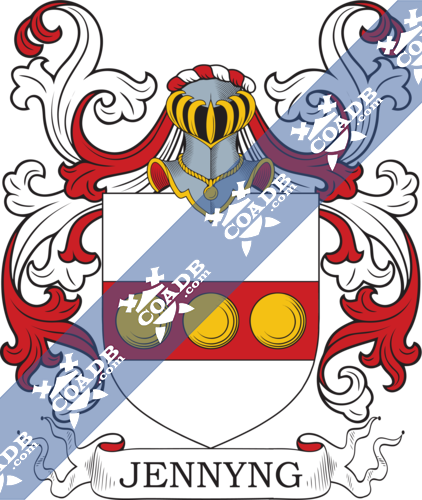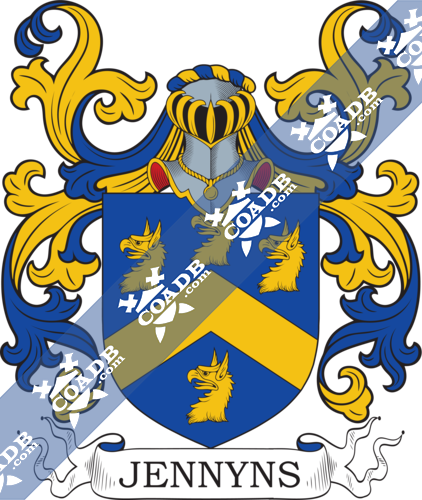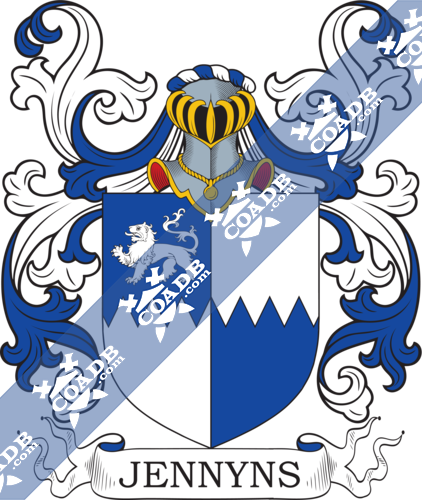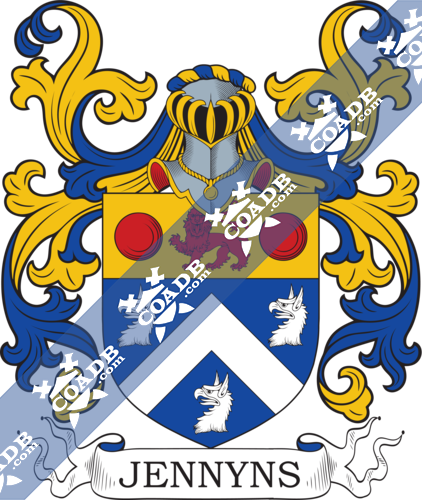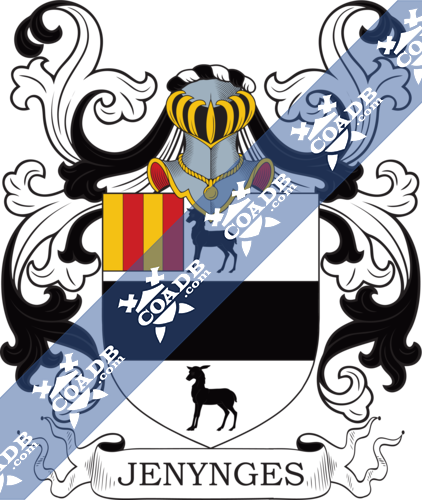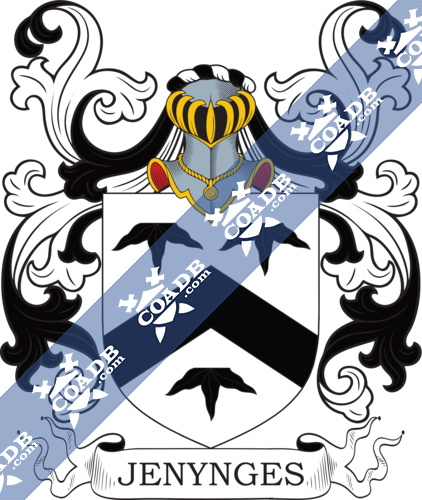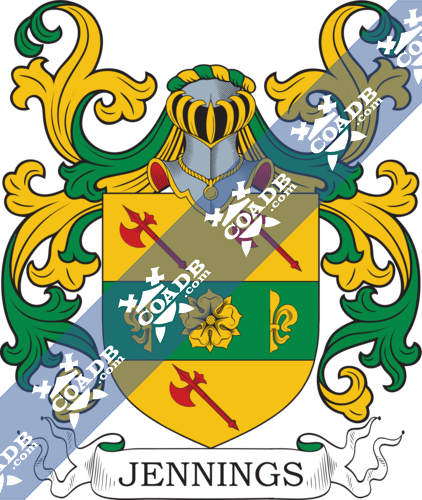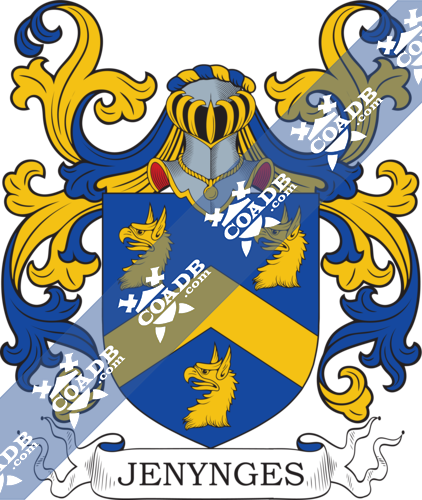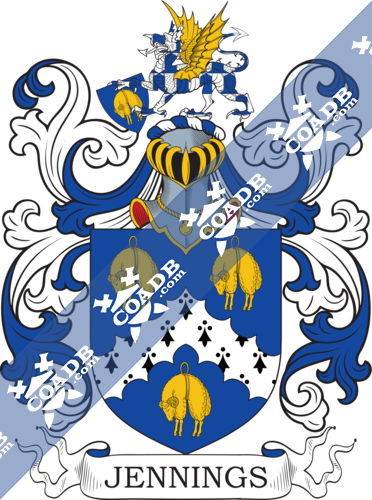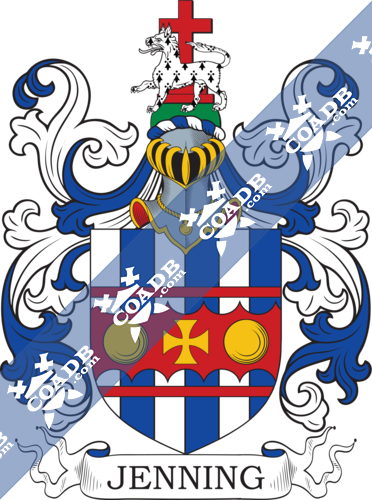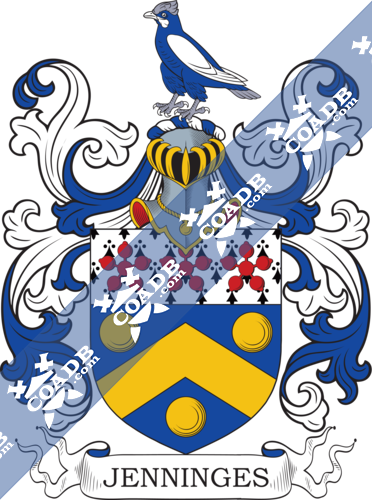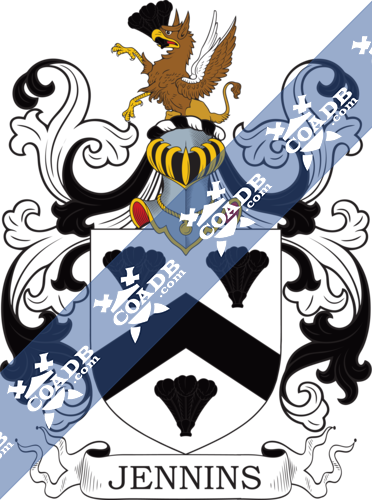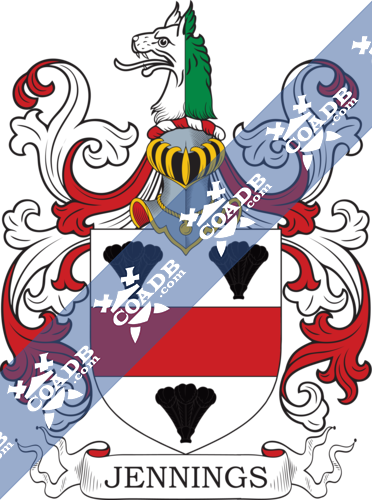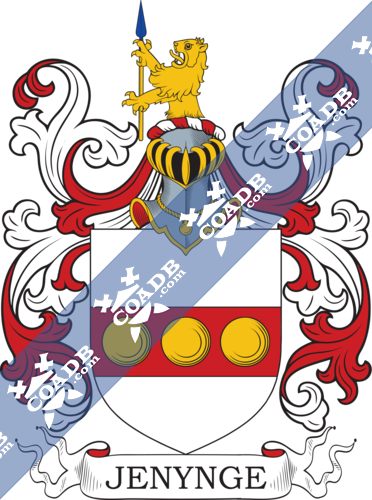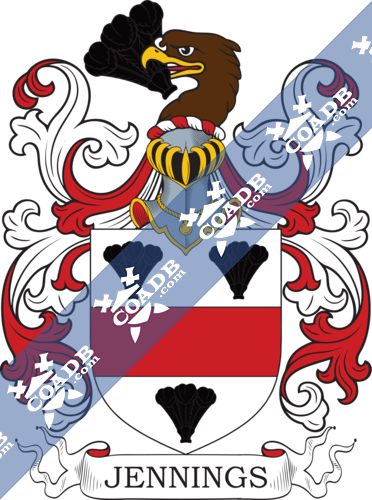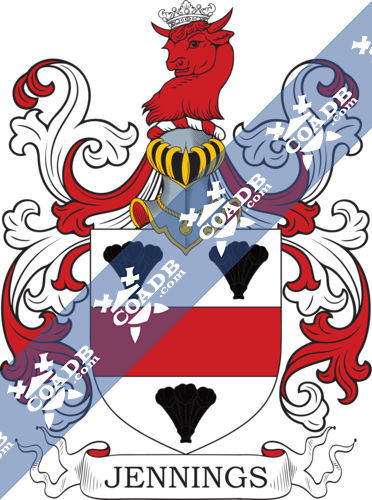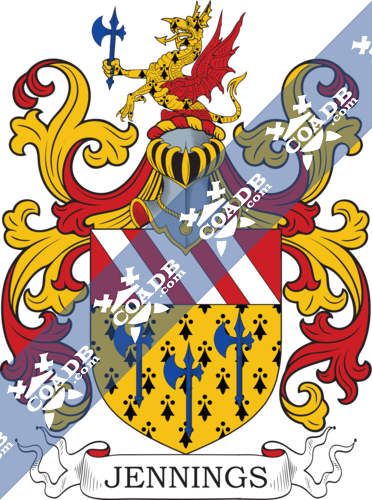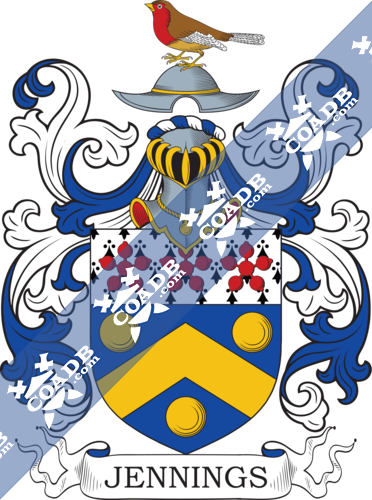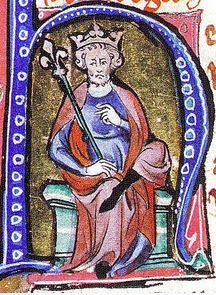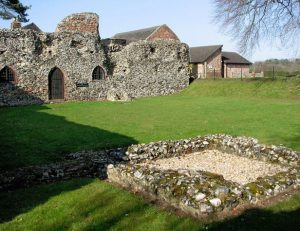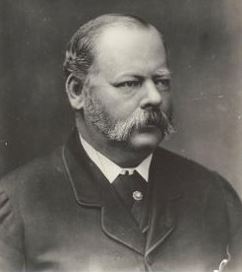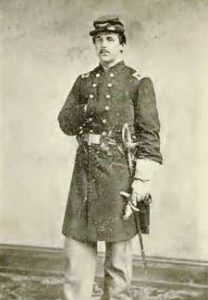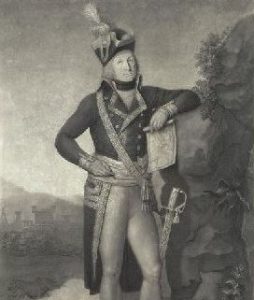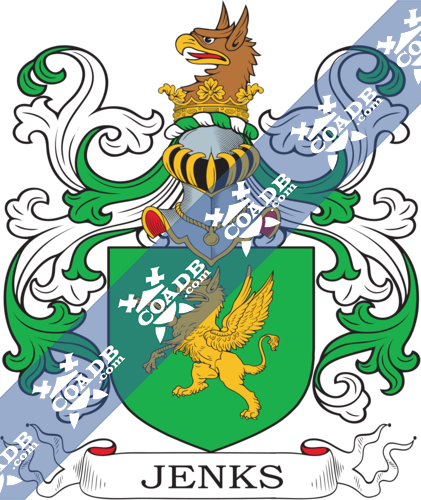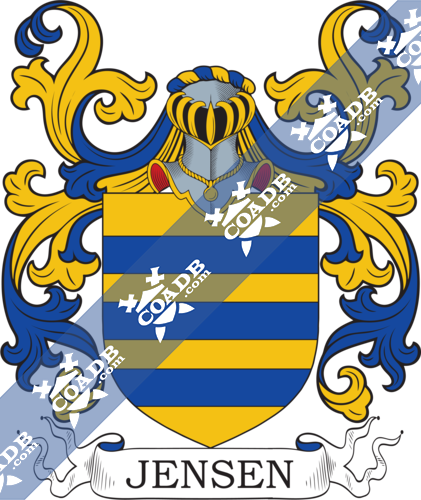Jennings Family Crest, Coat of Arms and Name History

Jennings Coat of Arms Gallery
Don’t know which Coat of Arms is yours?
We can do a genealogical research. Find out the exact history of your family!
Learn MoreMeaning, Origin, Etymology
There are many theories of where the Jennings name actually originated although no matter which theory you take it is most likely true. The first is that the Jennings name derives from the given name of Janyn or Jenyn which is a form of John and means “Little John”. John itself derived from the Hebrew name of “Yochanan” meaning “Jehovah has favoured me with a son”, otherwise being a patronymic surname meaning “the son of Little John”, which dates all the way back to the 13th century. The second is that the Jennings name originated in Yorkshire and the family were Saxons before the Conquest of 1066 which would have given the Jennings a Danish origin. No matter what the origins of this name it has spread throughout England and the World. Within England it can be found in Yorkshire, Derbyshire, Warwickshire, Hertfordshire, Surrey and Somerset. In Ireland the surname seems to be of Anglo-Norman origin and originated from the names of MacSheoinin or MacJonin meaning the “son of Little Sean”. These families can be found in Burke, Mayo and Galway and were of strong Catholic faith. There is a source The Baronetage of England: Or The History of the English Baronets Vol. 1 published in 1801 by the Reverend William Betham that states that the Jennings name is derived from Jernegan, Jerningham and Jenihingo. There is a note on page 223 of this edition that is shown below in the genealogy section. Robert Jennings of Shettle in Derbyshire was one of Henry VIII’s favorites. In 1545 he presented Robert with a sword which he preserved and gave to his descendants. There was a family of Jennings that inherited an estate called Sandridge in Hertfordshire from the Rowlatts in the 1570’s. He was knighted in 1603 and died a lunatic in 1609. His son Sir John Jennings was High Sheriff for Hertfordshire and the MP for St. Albans. There was a John Jennings of Ballymurphy in Ireland that forfeited his estate 1633 rather than convert to the Catholic religion. A descendant of his was Sir Patrick Jennings who became Premier of New South Wales in 1886. There were many Jennings that immigrated to America some of which were Nicholas Jennings, Joshua Jennings, Stephen Jennings and John Jennings. There are many families with the last name of Jennings but they are not all directly related.
Spelling Variations
Jennings, Jenings, Jennins, Jennyns, Jennens, Jennynge, Jennynges, Jenyns
Popularity & Geographic Distribution
The last name Jennings ranks 3,244th in popularity worldwide as of the 2014 Census and approximately 173,975 people carry the Jennings surname worldwide. The name ranks particularly high in the following six states: Texas, California, Virginia, Missouri, Florida, and New York. It ranks highest in the following countries: United States (116,437), England (26,080), Australia (10,719), Canada (5,239), South Africa (3,495), Ireland (3,093)
Early Bearers of Surname
Francis Jenance, or Jennens, or Jenens: ibid.
Jane, d. of Stephen Jenyn, 1548: Keg. St. Columb Major.
Janyn de Gynes, 1379: Poll Tax of Yorkshire.
Janyn le Breton, Lancashire, 1332: Lay Subsidy (Rylands).
Janyn serviens Johannes warde, 1379: ibid.
Jeames Jennynges: St. Peter, Cornhill. Buried 1571.
Jeffrey Jennings was christened on August 24th 1561, at St. Dunstans in the East, London
Jenyn de Fraunce, 1379: ibid.
John Genens, or Jenens, citizen of Oxford, 1573: Register of the University of Oxford.
Ralph Jenyngs, of Chester: Wills at Chester. 1610
Roger Jonyng, which was dated 1296, in the Subsidy Rolls of the county of Sussex
Saint Edmund Gennings (1567-1591), an English Catholic martyr, who was executed during the English Reformation
Sir Stephen Jenyns (c.?1450-1523), English wool merchant from Wolverhampton who became Sheriff of London in 1499
Thomas Jennyns, was christened on August 9th 1544, at St. Pancras’, Soper Lane, London
Thomas Jenyn, in the charter rolls of 1428 known as “Inquisitions and Assessments relating to Feudal Aids”
Walter Jannes and Richard Janyns in the Subsidy Rolls of Worcestershire of 1327
JERNINGHAM OR JENEGAN OF COSSEY, NORFOLK
***NOTE: Weever, tells us, that “the name of Jerningham has been of exemplary note from before the conquest, and adds the following account, as extracted out of a pedigree of the family. Canute, King of Denmarke and of England, after his return from Rome, brought with him diverse captains and soldiers from Denmarke, whereof the greater part were christened here in England, and began to settle themselves here, of whom Jernegan or Jerningham and Jenihingo, now Jennings, were of most esteem with Canute, who gave unto the sayde Jerningham certaine royalties; and at a parliament held at Oxford, the sayde King Canute did give unto the sayde Jerningham certaine manors in Norfolke; and to Jennings certaine manors, lying upon the sea side, neere Harwich in Suffolke, in regard of their former services done to his father, Swenus, King of Denmark.”***
This family is said to be of Danish extraction. (see note above) The first I meet with upon record is Jernegan who is mentioned in the Castle Acre Register as witness to a deed without date, by which Bryan, son of Scotland, confirmed the church of Melsombi to the monks of Castle Acre, and died about the year 1182. He married Sibilla, who in 1183 paid 100l. of her gift into the Exchequer. His son was called Hugh or Hubert Fitz Jernegan: he gave a large sum of money to King Henry II and paid it into the Exchequer anno 1182. He was witness to a deed in 1195, by which divers lands were granted to Byland Abbey in Yorkshire. He married Maud, daughter and co-heir of Thorpine, son of Robert de Watheby, and died anno 1203. he was succeeded by his son, Sir Hubert Jernegan or Jerningham of Horham, in Suffolk, Knight who had been engaged in the insurrection of the barons against King John; but on the accession of Henry III in 1216, he submitted himself, and obtained his pardon. But it seems that he had not recovered all his estates in 1219; for in that year Gilbert de Gant gave to Robert Marninson, jun. the wardship of the land late Hugh Jernegan’s in Hundemaneby; and in the year 1240 Margery late wife of Hubert Jernegan, sued Hugh Jernegan, her son, for lands in Stonham-Jernegan in Suffolk; so that he died about the year 1239. He married Margery, daughter and heir of Sir de Herling of East Herling in Norfolk, Knight and by her had issue four sons, Godfrey, William, Robert and Hugh. He was succeeded by his second son, Sir William Jernegan, Knight who married Julian, daughter and co-heir of Sir Gymingham of Burnham, Knight. He died without issue, and was succeeded by his youngest brother, Sir Hugh Jernegan, Knight who in the year 1243 entered into an agreement with his mother Margery, and settled upon her, in lieu of the dower of Sir Hubert, her late husband, the capital messuage and manor of Horham in Suffolk, with the park, windmill, and demean lands, and the services and rents of Horham manor, with house-bote, hey-bote, and pannage; and in consideration of this settlement Margery released all her right in Dower, in two carucates of land, and a messuage in Stonham-Jernegan in Suffolk, and in all his other estates in Norfolk and Suffolk. Sir Hugh died about the last year of the reign of King Henry III and was succeeded by his son, Sir Walter Jernegan of Horham, and of Stonham-Jernegan, Knight who married Isabella, daughter and at length heir of Sir Peter Fitz-Osbert of Somerley Town in Suffolk, Knight. This lady was the widow of Sir Henry de Walpole, Knight ancestor to the late earls of Orford, and was endowed with a third part of the manor of Houghton, in the same county, as appears by a charter, wherein she is styled “the lady Isabella Jernegan, late wife of Sir Henry de Walpole, father of Sir Henry de Walpole,” then living. She afterwards became co-heir to her brother, Roger Fitz-Osbert, summoned among the barons to parliament 22 Edw. I. Sir Walter must have died before the 34th of Edw. I his wife Isabella being described that same year as a widow, 40 years of age. He was succeeded by his son, Sir Peter Jernegan of Somerley-Town, Knight who on the death of his mother succeeded to the large possessions of the Fitz-Osbert family for his maternal uncle, Roger baron Fitz-Osbert, dying without issue, the estates devolved to Isabella, his mother, and to the issue of Alice, her sister and co-heir, married to Sir John Noyoun, Knight on a division made between the two sister, the manor of Somerley Town and Uggeshall in Suffolk, and Hadeston and Wittingham in Norfolk, were settled upon Isabella. From this period until the reign of King James I. Somerley became the chief seat of the Jerningham family. It appears from the Eye Register that Sir Peter’s first wife was Alice, daughter of Hugh Germanyne and Basil his wife; his second is stated to have been Matilda, daughter and heir of Sir Roger Herling, and also of Sir Peter Fitzmortimer; and that his third was Ellen, daughter of Sir Roger de Huntingfield, of Huntingfield in Suffolk, Knight. He appears to have died at an advanced age, toward the middle of the reign of King Edw. III and was succeeded by his son, Sir John Jerengan of Somerley, Knight he married Agatha, daughter of Sir Robert Shelton in Norfolk and was succeeded by his son, Sir John Jernegan, sen. of Somerley, Knight. This Sir John inherited the other Moiety of the Fitz-Osbert estates, at the death of his cousin, Sir John Noyoun, Knight. He married Joan, daughter and co-heir of Sir William de Kelvedon, relict of Sir John Lowdham of Frense, in Norfolk; she was jointly seized of all is manors of Somerley-Town, Wathe, Horham, at the time of his death, anno 1375; and was succeeded by his son, Sir John Jernegan, jun. of Somerley, Knight who in 1374 married Margaret, daughter of Sir Thomas Vise de Lou, Knight of an ancient Norman family and his father then settled the manor and advowson of Stonham-Jernegan, and Horham, upon them and their heirs. The had issue two sons and two daughters; Sir Thomas, their successor, Humphrey, who died in 1446, Alice, the wife of John Cleresby, and Elizabeth wife of John Gonvile, Esq. Sir Thomas Jernegan of Somerley, Knight in 1406 had a charter of free warren in Somerley, Flixton, Ilketishall, and Wathe, in Suffolk and Hadeston, Bunwell, in Norfolk. He married Joan daughter of John Appleyard of Dunston, in Norfolk, Esq., and was succeeded by his son, John Jernegan of Somerley, Esq. who married Joan, daughter of Sir John Darell of Cale Hill, in Kent, Knight ancestor of the present ___ Darell, Esq. of the same place. She died before him and was buried in St. Mary’s Chapel in the priory of St. Olave at Herringfleet in Suffolk, now called St. Tooley’s Bridge. He was succeeded by his son; John Jernegan of Somerley, jun. Esq. upon whom on his marriage in 1459 with Isabella, daughter and heir of Sir Gervase Clifton, Knight his father had settled the manor of Horham, and had also given up to him the family seat at Somerley, and retired himself to Cove near Beccles, where he was living in 1465. John Jernegan, jun. died in 1503. He left issue two sons, Sir Edward and Sir Richard, and several daughters; Mary was the wife of Thomas Stanhope, Esq. ancestor of the present earl of that name. His second son, Sir Richard, was with King Henry VIII in his wars in Flanders, and there received the honour of knighthood. He was sent by him in 1523, as his ambassador to the Emperor Charles, then in Spain. Several letters of correspondence with Cardinal Wolsey at that time, extant are among the Harlean manuscripts in the British Museum. Sir Edward Jernegan of Somerley, Knight eldest son and heir of John Jernegan, jun. had two wives; his first was Margaret, the only daughter of Sir Edmund Bedingfield of Oxburgh, in Norfolk, Knight (ancestor of the present Sir Richard Bedingfield, Bart.) who died March 24, 1504. From this marriage came the Jernegans of Somerley-Town, now extinct. His second wife was Mary, daughter and co-heir of Richard Scroope, second son of Henry Lord Scroope, of Boulton, re-married to Sir William Kingston, Knight of the Garter; she died in 1548 and lies buried in the church of Leyton, with an inscription on a brass tablet against the wall. By this lady Sir Edward had issue, Sir Henry Jernegan of Huntingfield, Ferdinand, Edmund gentleman of the bed-chamber to King Henry VIII and died Feb. 9, 1546, Edward born after his father’s death and Elizabeth maid of honour to Queen Mary. Sir Henry Jerningham of Huntingfield and Wingfield, in Suffolk, and founder of the Cossey family, was one of the first, with the earls of Sussex, Bath and Oxford, Lord Wentworth, Sir Thomas Cornwallis, Sir Henry Bedingfield, Sir William Waldegrave, and several others of the Norfolk and Suffolk gentry, who came forward in support of Queen Mary, at the death of Edw. VI and proclaimed her very considerable in and about the town of Yarmouth, Sir Henry was enabled to get possession of six large ships, which proved of signal service to the queen’s party. He was afterwards commander of the forces under the Duke of Norfolk, when sent to suppress the insurrection of Sir Thomas Wyat, and routed the rebels near Charing Cross, after their failure at Whitehall, and in their attempt to follow their leader into the city. He was immediately on the queen’s accession, made privy councellor, vice chamberlain, captain of her guard, and lord-lieutenant of the county of Kent. She also made him a grant, by letters patent, of several large manors in Norfolk, Suffolk, Herefordshire, and Gloucestershire and particularly of the manor of Cossey. Sir Henry pulled down the old hall at Cossey, which stood under the hill, on the south side of the water, and erected the present mansion house which he finished in 1564, as appears by the date over the porch. He resided during the building of it at the royal palace at Eltham in Kent, of which he was keeper. He married Frances, daughter of Sir George Bynham of Cloriwell in Gloucestershire, Knight and heir to her maternal uncle, Sir Anthony Kingston. This lady brought into the family the manor of Painswick in Gloucestershire. She survived her husband, and had the estate of Cossey settled upon her life.
ALBERT GOULD JENNINGS
Jennings, Albert Gould, of N.Y. City (son of Abraham Gould Jennings of N.Y. born Aug 28, 1821 married April 17, 1851, Cecilia Matilda died Jan 6, 1890, daughter of John Post Douglas. Mr. Albert Gould Jennings is 6th in descent from Lieut.-Govr. Gould of Conn.; 5th from Major Peter Burr; Colonel Abraham Gould killed in Revol.; 7th from Lt.-Col. Talcott; 6th from Col. John Burr; 5th from Capt. John Burr. Born in Brooklyn N.Y. Oct. 13, 1869: Graduated at Princeton University 1890; married October 24, 1894, Susie Beatrix daughter of John D. Crimmins of N.Y. City. Issue: Albert Gould Jr. born Nov. 15, 1897
Arms – Argent, a chevron gules between three plummets sable
Crest – A griffins head or, in the beak a plummet sable in pale.
Motto – Il buon tempo verra
Residence – a East 82nd Street, N.Y. City
Clubs – Union, University, Tuxedo, Country of Westchester, Racquet and Tennis
Societies – St. Nicholas, Sons of the Revolution, Colonial Wars
JENNINGS
The Hon. Sir Patrick Alfred Jennings, K.C.M.G., LL.D., M.L.C., and a hereditary Roman marquess of Colebrook, Double Bay, Sydney, or Garrawilla, New South Wales, and of Westbrook Queensland, born 20th March 1831, married 9th February 1861, Mary Anne eldest daugther of Martin Shanahan, of Marnoo, Victoria, and has issue, 1) John Francis born 22nd November 1868. 2) Alfred Martin Peter Paul born 29th June 1872. 3) Mary Judith Antonina. Sir Patrick was educated a Newry, in Ireland and at Exeter in County Devon England. Originally intended for the Bar, he determined to embrace a mercantile career, and finally resolved to leave England for Australia. He arrived in Melbourne in 1852, and went to the gold fields, and settled afterward at St. Arnaud, Victoria, in 1855, into which district he was among the first to introduce quartz-crushing machinery. He founded the town of St. Arnaud, was chairman of the first road board, and of the first municipal council of that place. He was made a magistrate for Victoria in 1857, and was chairman of the local bench for some years. In 1863 he went to reside at Warbreccan, near Deniliquin, having acquired some pastoral property in the Murrumbidgee district, and became an active member of the Riverina Association. He became possessed, in conjunction with his partner, Mr. Shanahan, of Marnoo, of station properties on the Murray and Darling Rivers. From 1867 to 1870, Sir Patrick was a member of the Legislative Council, and from the latter year to 1873, was a member of the Legislative Assembly for the Murray District. In 1874, he received from the Pope the Order of St. Gregory the Great. He was commissioner for New South Wales at the Victorian Exhibition, and for New South Wales, Tasmania, and Queensland, at the Great Centennial Exhibition of Philadelphia in 1876. In 1879 he was Executive Commissioner to the first Sydney International Exhibition, and for his services was created a C.M.G. In 1880, he was promoted K.C.M.G., and in that year was elected to to the Assembly for the Bogan District, which he represented till 1885. He was Vice-President of the Executive Council in the Stuart Government 1883, and was Colonial Secretary in the Dibbs Administration 1885. In February 1886, Sir Patrick formed a government of his own, of which he was Premier and Treasurer, and also Vice-President of the Executive Council, but resigned in January 1887. He proceeded to England in that year as delegate to the Colonial Conference, held in London. While on a visit to Ireland, the degree of LL.D., homoris causa was conferred on him by Dublin University. He subsequntly received from His Holiness Pope Leo XIII, the Grand Cross of Pius IX in addition to his previous distinctions, and was created a hereditary marquess by the Pope in April 1891. Sir Patrick was for many years Vice-President of the Agricultural Society and President of the leading musical societies in Sydney. He is a member of the Legislative Council, and is a magistrate for New South Wales, Victoria South Australia, and Queensland. He is also a member of the Sydney University Senate and a Fellow St. John’s College, and is Trustee of the Sydney National Art Gallery. Sir Patrick was Parliamentary delegate to represent the Legislative Council of New South Wales in the Sydney Federal Convention of 1891.
Lineage ~ In the records of the Rolls, we find that John Jennings was dispossessed of the townland of Ballymurphy in the barony of the Ards, parish of Ballykeel, and of several other valuable properties of the Roman Catholics by the penal code of Henry VIII and Elizabeth. This John Jennings was father of Robert from whom descended Robert Jennings, whose son, Robert Jennings married Mary McMullen, and left issue a son, Francis Jennings of Newry, Ireland, who married 1819 Mary O’Neil and died in Newry in March 1847, having by her, who died in Sydney in November 1874, had issue, 1) Patrick Aflred (Sir) the subject of this memoir. 2) John married Sarah Jordan and died in San Francisco, U.S.A. in 1882 leaving a son and daughter. 3) Francis died unmarried 4) Peter Vincent Joseph died unmarried 5) Mary Anne married Michael George Conway. 6) Rose married Thomas Bacon and died in Melourne in 1873, leaving by him who died in 1879 seven children. 7) Elizabeth married first John Quiqley, of Castle Blaney, Ireland and secondly, Thomas Gormley of St. Arnaud, Victoria, and has issue, two daughters. 8) Margaret Blanche, married 1871, Hubert Kelly
Residences and Estates ~ Colebrook, Double Bay, Garrawilla, Liverpool Plains in New South Wales and Westbrook, Darling Downs, Queensland.
Club ~ Union, Sydney
WILLIAM WESLEY JENNINGS
Elmina Elizabeth Boas born July 7, 1813 in Harrisburg, Pennsylvania died October 10, 1884 in Harrisburg, Pennsylvania married William Jennings born September 23, 1807, in Juniata Valley, Pennsylvania died October 6, 1875 in Harrisburg, Pennsylvania and there buried. He was the son of William Jennings who raised a company for the War of 1812-14, but who died suddenly before the company left home; he went to Harrisburg, Pennsylvania about the year 1823, to learn blacksmithing, subsequently establishing a foundry, which he successfully carried on until near the close of his life. He was an enterprising citizen, active and influential in the public affairs of the municipality from 1830 to 1850, and in the church, of which he and his wife were consistent members, (the first Methodist), prominent and zealous. They had issue: 1) Elmer Fredrick born May 1833 died December 22, 1876. 2) William Wesley born July 22, 1838 married Emman Van Horn. 3) Elizabeth M. born September 8, 1843 married B. Frank Scheffer October 15, 1867 of Harrisburg and had issue, Theodore William and Nellie Boas. 4) Elmina Regina born January 8, 1845 died August 17, 1846. 5) Mary Emma born September 26, 1847 died January 16, 1857. 6) Fannie Boas born March 9, 1854 died December 23, 1869. William Wesley Jennings born July 22, 1838, in Harrisburg, Pennsylvania died February 28, 1894. He attended the public schools of Harrisburg until his fifteenth year, when he commenced to learn the trade of iron-molder in his father’s foundry. From 1860 to 1875 he was engaged in the iron business. During the war of the Rebellion he raised the One Hundred and Twenty-Seventh Regiment, Pennsylvania Volunteers, a nine months’ regiment, and was in the battles of Fredericksburg and Chancellorsville. Shortly after being musterd out of service, the Gettysburg campaign opened and Colonel Jennings was placed in command of the Twenty-Sixth Regiment, Pennsylvania Militia. The following account concerning it we have from Jacobs’ “Battle of Gettysburg:” “The Twenty-Sixth Regiment arrived at Gettysburg on Friday the 26th of June, and by order of Major Haller, although contrary to the earnest remonstrances of Jennings, colonel of the regiment was sent forward at 10:30 a.m., on the Chambersburg turnpike. This was a suicidal movement of a handful chiefly of inexperience men, in the face of a large body of experience troops. The rebels afterwards laughed at the folly of the order. But, advancing to the distance of about three miles westward, our little band encamped and threw out their pickets. At about 3 p.m., the rebels in force made their appearance and captured nearly all their pickets, forty in number. Colonel Jennings, who had on several occasions shown himself to be an officer as skillful as he is cool and brave, seeing the trap into which he had been led, immediately, upon sight of the enemy, divided the regiment into three squads, in order to deceive them with the appearance of a large body of infantry. The deception proved so far successful that the rebels did not press them, fearing that a direct attack might prove more serious than a mere skirmish. Jennings’ command, however hastily retreated eastward over the fields and by country roads, occasionally skirmishing with the enemy’s cavalry, which was sent in pursuit of them; and after losing one hundred and twenty men of their number near Hunterstown, and zigzagging very frequently, being often within hearing distance of their pursuers, they reached Harrisburg on Sunday the 27th of June, much fatigued, having marched fifty-four out of sixty continuous hours. Too much praise cannot be awarded Colonel Jennings for the skillful manner in which he conducted this retreat and saved the regiment from capture.” From 1863 to 1866, Colonel Jennings served as sheriff of the county of Dauphin, and again from 1876 to 1879. At the breaking out of the railroad riots in July 1877, Colonel Jennings was absent from home, but, hastening to the State Capital, he at once assumed control, organized the citizens, and restored peace to the city, seriously threatened with mob violence. His example as favorably commented upon at the time, not only by the newspaper press in general, but by the Governor of the State in his annual message, and was deserving of all praise. Upon the death of Mr. Calder, President of the First National Bank of Harrisburg, in 1880, he was elected to that position, in which he continued until his decease, and also President of the Commonwealth Guarantee Trust and Safe Deposit Company. In 1884, he was chosen a director of the Cumberland Valley Railroad Company. Colonel Jennings married December 17, 1861, Emma Van Horn born November 26, 1842. They had issue: 1) Frederick Boas born November 13, 1862 died February 28, 1870. 2) Mary born September 7, 1864. 3) William born August 18, 1868 married October 18, 1892 Jean Belle West daughter of Rev. William A. West, and have issue Dorothy born December 2, 1898. 4) Fannie born January 7, 1870 and 5) Harry born March 31, 1872.
Early American Immigration and New World Settlers
Catherine Jennings, aged 19, who landed in New York, NY in 1848
Charles Jennings, who arrived in New York in 1835
Edward Jennings, who landed in New York in 1838
George Jennings, who landed in New York in 1826
Jon Jennings, who arrived in Virginia in 1635
Joseph Jennings, who landed in New York in 1835
Joshua Jennings, believed to have been the brother on Nicholas Jennings, was one of the first settlers of Fairfield, Connecticut in the early 1650’s
Mary Jennings, who landed in Maryland in 1633
Mary Jennings, who settled in Maryland 1633
Nicholas Jennings who arrived in 1634 on the Francis from Ipswich
Nicholas Jennings, aged 22, who landed in New England in 1634
Richard Jennings, aged 35, who landed in Bermuda in 1635
William Jennings, who landed in Leeward Islands in 1703-1704
Mottoes
Conservabo ad mortem. I will preserve it till death.
It buon tempo verra. Bright days will come.
Ut prosim aliis. That I may be of use to others.
Grantees
.Jenins [Jennings], William, Lancaster Herald, 10 Feb. 1510-17, by “Wriothesley [Gart.] and Benoit [Clar.]. Harl. IMS. 1107, fo. 82’’.
Jenings (Peter in Gnil., p. 304), of Silsden, Yorks, grant 26 May 1041, by P>orongh. Harl. MS. 1105, fo. 57’’; Cains Coll. Cainb. MS. 551, copy of grant.
Jennings to Starkey, . . . ., of Wenbury Hall, co. Chester, and Allwoodley’, CO. York. (Match), 1811, Vol. XXVI, fol. 320.
Jennings, Robert, s. of Thomas, of Hartweli, co. Northampton, 1760, Vol. X, fol. 266.
Jennings,, Robert, of St. John’s, Westminster, co. Middx., 1760. (Edmondson’s Armory, Berry, and Burke.)
Jennings,. . . . (Cross and Starkey), of Allwoodlev, co. York. (Match), 1813, Vol. XXVII, fol. 360.
Jennings„ . . . ., Sheriff of York, [1847] Vol. XLVIII, fol. 363.
Jennings„ . . . ., of The Shrubbery, Bucklaud, ur. Dover, co. Kent, 183 . ., Vol. XLII, fol. 40.
Jennings„ Anne {see Lingard), 1871. (Geneal., V, p. 145.)
Jennings„ John (s. of John), of Llanrhusted, co. Cardigan, Wales, M.A., Preb. of Westminster (Bishop’s MS.), 16 June 1837, Vol. XLII, fol. 139.
Jennyns, Ralph, of Churchill, Somerset, crest confirmed …. 1503. (Harvey’s Grants), Add. MS. 10,940, fo. 53.
Lingard Monk, Boughet and Jennings quarterings aud RowsON, 16 Jan. 1871. (Geneal., V, p. 144.)
Starkey, late Jennings, . . . ., of co. York and Chester. (Match), 1811, Vol. XXVI, fol. 320.
[Jennings quartering. See Lingard-Monk. Genealogist, V, p. 144.] Jevon, Daniel au<l Thomas, add [Salopian Shreds and Patches, VIII, p. 36 ; r. W. Hackwood’s Sedgley Researches, 1898, p. 117]
Notables
Adam Jennings, English actor and film director
Adam Jennings (American football), American football player
Alex Jennings, British actor
Asa Jennings, American who commanded the evacuation of refugees after the Great Fire of Smyrna
Billy Jennings (born 1952), English footballer
Billy Jennings (Welsh footballer) (1893–1968), Welsh footballer
Brandon Jennings, American basketball player
Brian Jennings, American football player
Bryant Jennings, American boxer
Charles Edward Jennings de Kilmaine (1751–1799), Irish-born French general
Charles Jennings (journalist) (1908–1973), Canadian journalist
Christine Jennings, American politician
Claudia Jennings, American model and actress
Clyde Jennings (1916–2006), Florida philatelist
Edward Jennings (VC) (1820–1889), Irish recipient of the Victoria Cross
Edward Harrington Jennings (born 1937), tenth president of Ohio State University
Edward L. Jennings (born 1968), Florida politician
Edward Jennings (rowing) (1898–1975), American coxswain
Elizabeth Jennings, English poet
Elizabeth Jennings Graham (1830–1901), American black civil rights activist and teacher
Ernie Jennings (born 1949), American football player
Francis Jennings, American historian
Gary Jennings, American author
Gavin Jennings, Victorian Politician
George Jennings, pioneering British sanitary engineer
Gerald H. Jennings, ichthyologist and author
Greg Jennings, American football player
Henry Jennings, British privateer
Henry Constantine Jennings, English antiquarian
Herbert Spencer Jennings, zoologist, geneticist and eugenicist
Hughie Jennings, American baseball player
Humphrey Jennings (1907–1950), English filmmaker
James Jennings (born 1960), Irish philosopher
Jeremy Jennings, English political theorist
Jesse D. Jennings (1909–1997), American archaeologist
John Jennings (disambiguation), several people
Jonas Jennings, American football player
Jonathan Jennings, first governor of Indiana
Keaton Jennings. English cricketer
Keith Jennings (American football) (born 1966), American football player
Keith Jennings (basketball) (born 1968), American basketball player and coach
Keith R. Jennings (born 1932), English chemist
Keith Jennings (cricketer) (born 1953), English cricketer
Ken Jennings, holder of longest winning streak on the game show Jeopardy!
Kenneth Jennings, composer and director of the St. Olaf Choir
La Vinia Delois Jennings, American literary scholar
Luke Jennings, British author of the novel Codename Villanelle
Lyfe Jennings, American musician
Lynn Jennings, American distance runner
Marlene Jennings, Canadian politician
Mason Jennings, American musician
Michael Jennings (disambiguation), several people
Morley Jennings (1890–1985), American college sports coach
Professor Nick Jennings, Regius Professor of computer science
Owen Jennings, New Zealand politician
Pat Jennings, Northern Irish footballer
Patrick Jennings (1831–1897), Australian politician
American Revolution Veterans
Augusts Jennings enlisted April 3, 1775 in Virginia
Austin Jennings enlisted July 12, 1775 in Virginia
Baylor Jennings enlisted February 3, 1775 in Virginia
Elnathan Jennings enlisted June 28, 1775 in New York
James Jennings enlisted January 7, 1775 in Virginia
Jeremiah Jennings enlisted July 1, 1775 in New Jersey
Nathan Jennings enlisted 1775 in Connecticut
Soloma Jennings enlisted November 12, 1775 in Virginia
Civil War Veterans
Alex Jennings born 1819 in Knox, Ohio
Auguster Jennings born 1819 in Illinois
Benjamin F. Jennings born 1819 in Webster, Missouri
David Jennings born 1819 in New York
Ebenezer Jennings born 1819 in Tuscola, Michigan
George Jennings born 1819 in New Hampshire
Hugh Jennings born 1819 in New York
Imael Jennings born 1819 in Spencer, Indiana
Isaac Jennings born 1819 in New York
Jacob O. Jennings born 1819 in Holmes, Ohio
James H. Jennings born 1818 in New York
James Jennings born 1819 in Kent, Michigan
John M. Jennings born 1819 in Illinois
Julius Jennings born 1819 in Kent, Michigan
Lewis Jennings born 1819 in New York
Orrin B. Jennings born 1819 in Trumbull, Ohio
Patrick Jennings born 1819 in Wisconsin
Rufus H. Jennings born 1819 in New York
Thomas Jennings born 1819 in Pennsylvania
Blazons & Genealogy Notes
1) (Harlington, co. Bedford). Erm. a lion ramp. gu.
2) (Oldcastle, co. Chester, and co. Salop). Ar. a fesse gu. betw. three plummets sa. Crest—A wolf’s head erased per pale ar. and vert.
3) (co. Devon). Or, on a fesse vert betw. three battle axes gu. a rose betw. two demi fleurs-de-lis or.
4) (co. Cornwall. Visit. Cornwall, 1620). Erm. a lion ramp. gu.
5) (William Jennings, Lancaster Herald, 2 May, 1526, grandfather of Jeffrey Jennings, Esq., of Ipsley, co. Warwick). Az. a chev. betw. three griffins’ heads erased or, a chief of the last.
6) (Lord Mayor of London, 1508, and co. York). Ar. a chev. gu. betw. three plummets sa. Crest—A wolf’s head erased par pale ar. and vert (another, ar. and sa.). Another Crest—An eagle’s head couped ppr. holding in the beak a plummet sa.
7) (Harwich, co. Essex). Same Arms. Crest—A bull’s head gu. corned ar. Motto—Virtus basis vitae.
8) (St. John’s, Westminster, co. Middlesex; granted 1760, to Robert Jennings, Esq.). Erminois three battle axes erect az. two and one, on a chief gu. three bendlets ar. Crest—A demi dragon erminois, wings endorsed gu. erased of the last, holding a battle axe erect az. Motto—Il buon tempo verra.
9) (Burton, co. Somerset, and Pynsent, co. Devon). Az. a chev. or, betw. three bezants, on a chief erm. as many cinquefoils gu. Crest—A redbreast sitting on a morion.
10) (Ripon and Lilesden, co. York; granted 1641). Ar. a chev. betw. three plummets sa. Crest—A griffin’s head couped betw. two wings inverted ppr. in the beak a plummet pendent sa.
11) (Hayes, co. Middlesex). Ar. on a fesse gu. three bezants (another, or, on a fesse gu. three plates). Crest—A demi lion ramp. or, holding the upper part of a spear-shaft of the last.
12) Az. a chev. betw. three griffins’ heads erased ar. Crest—A cat’s head erased guard, gu. bezantée, holding in the mouth a cross pattée fitchée ar.
13) (The Shrubbery, Dover). Az. a chev. engr. erm. betw. three toisons or. Crest—A dragon pass, vair, wings or, the dexter claw resting on a shield az. charged with a toison gold. Motto—Conservabo ad mortem.
14) (confirmed to William David Jennings, Esq., Procurator-General in the Arches Court of Canterbury, son of David Jennings, Esq., of Dublin). Ar. a lion ramp. gu. holding in the paws a battle axe ppr. on a chief az. three ducal coronets or. Crest—Out of a ducal coronet or, a demi lion ramp. sa. holding in the paws a battle axe ppr.
15) Ar. a chev. betw. three hinds sa. a quarter paly of four or and gu.
16) (granted to the Rev. John Jenning, of St. Peter’s, Westminster). Paly of six ar. and az. on a fesse engr. betw. plain cotises gu. a cross pattée or, betw. two bezants. Crest: On a mount vert a wolf pass. erm. in front of a cross calvary gu.
17) Az. a chev. or, betw. three bezants, on a chief erm. three cinquefoils gu. Crest—A jay ppr.
18) (Milford, co. Hants). Ar. a chev. betw. three plummets sa. Crest—A demi griffin ppr. in the beak a plummet sa.
19) Az. a chev. or, betw. three bezants, on a chief erm. as many cinquefoils gu. Crest—A griffin pass. gu. holding a buckle or.
20) Ar. on a fesse gu. three bezants.
21) (Ipsley, co. Warwick. Visit. Warwick, 1319). Az. a chev. betw. three griffins’ heads erased ar. on a chief or, a lion pass. gu. betw. two torteaux. Crest—A leopard’s head erased and guard, gu. bezantée, holding in the mouth a cross formée fitchée ar.
22) (co. Middlesex). Az. a chev. betw. four griffins’ heads erased or, three and one.
23) (co. Middlesex). Quarterly, per fesse indented az. and ar., in the first quarter a lion pass. of the second.
24) or Jennings – (Fun. Ent. 1699, Stephen Jennyns, Clerk of Her Majesty’s Works in Ireland). Az. a chev. betw. three griffins’ heads erased ar. on a chief or, a lion pass. guard. gu. betw. two torteaux.
25) (co. Hants, and Hesse, co. Middlesex). Ar. on a fesse gu. three bezants. Crest—A demi lion erased and ramp, or, supporting a spear erect gold, headed az.
26) (co. Devon). Ar. a fesse betw. two hinds sa. a canton paly of four or and gu.
27) (London). Ar. a chev. gu. betw. three fishes’ heads erased sa.
28) (London). Ar. a chev. betw. three demi estoiles couped per fesse sa. rays in base.
29) (co. Suffolk). Or, on a fesse vert betw. three halberts az. staves gu. a fleur-de-lis betw. two demi roses paleways ar. seeded of the field. Crest—A demi savage sa. collared round the neck or, wreathed round the temples gold and vert, holding in the dexter hand a halbert az. staff gu.
30) or or Jenninges – Az. a chev. betw. three griffins’ heads erased or.
31) Ar. three torteaux in fesse.


